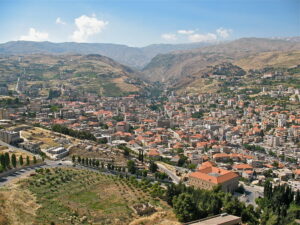When it comes to superior quality and grape growing and production of wine, famous wine regions like Napa Valley, Bordeaux, and Tuscany steal all the spotlight. However, there are some unlikeliest places around the globe where you will find several fine quality, worth tasting full-flavored wines.
We have come up with a few surprising and unlikeliest places to find wines that are both established and emerging.
1. Beqaa Valley, Lebanon
The ancient traceable wine-producing traditions belong to Lebanon, which dates back to 7000 B.C.E. Sarah Bray added that this country has a winemaking history that extends across the Roman Empire, Biblical times, and even into the Middle Ages. According to her, the Middle Eastern wine destination has been overlooked. The wineries of the regions are making waves, especially at an archetypal estate like Chateau Musar.
2. North Carolina
North Carolina, ranked 14th for wine and 13th in grape production nationally, was the first state to grow grapes. In recent years, entrepreneurs have turned back to winemaking after having declined in tobacco farming. Especially in the Yadkin Valley, the winemaking has started again because of its perfect soil, climate, and growing season, which resemble that of Burgundy, France.
Sweet native grapes like Scuppernongs, Cabernet Franc, and Muscadines, thrive here. Moreover, since the trail is so large, it is best to hit wineries in Forsyth, Davidson, and Davie regions one day. And those in Surry, Yadkin, and Wilkes countries the other time.
In North Carolina, the largest family-owned winery, Shelton Vineyards sponsors a concert series every summer at its 200-acre estate.
3. Abruzzo, Italy
If you are the one who is a fascinator of Italian wine, then you must have visited world-famous wine places like Tuscany and Piedmont. But if you are looking to go beyond the divine wine trial of Italy, you should head east towards the Adriatic coast of the country.
The characteristic that distinguishes Abruzzo from the rest of Italy’s wine regions is that it is well-known primarily for the production of Montepulciano grapes. Montepulciano d’Abruzzo, the resulting red wine, is low in acidity, tannic, and exceptionally easy to drink.
4. Western Colorado
The grape-growing regions of Colorado range in altitude from 4,000 to 7,000 feet and comprises of some of the world’s highest vineyard. The cold nights and hot days of the region stimulates the grapes to hold acids and assemble natural sugars.
Grand Valley, the home to eighteen wineries and birthplace of the resurgent wine industry of Colorado, is in due west along the l-70 corridor. Situated along the Colorado River, they shape a rough triangle with points at Whitewater, Grand Junction, and Palisade.
The most award-winning winery of the state, Plum Creek Cellars, is in the small farming city of Palisade on the Western lean of Colorado. You must taste stellar 2001 Cabernet Sauvignon of Plum Creek Cellars. Los Altos B&B is an ideal place for your stay since it is a delightful inn with fascinating views. It will make you feel like you are a part of the valley and mountains.
5. Western Iowa
In the United States, Iowa ranked sixth in the production of grapes in 1919, but years later, it went dry. Since the year 2000, more than 225 commercial vineyards have been established, and all the credit goes to recent resurgence. The seven wineries of the Western Iowa Wine now produces eight-six kinds of wines.
The trail, located in the Loess Hills, is one of the many appointed wine trails in Iowa. Here, the undulating terrain delivers the air drainage required to cultivate high-quality grapes. And the soil of the region resembles that of found in the Rhine, southern France, and Moselle river valleys.
A 3.5-acre vineyard, the King’s Crossing Vineyard and Winery make wine with 100 percent Iowa-cultivated grapes. Try its 2006 Guinevere’s Lace (white table wine), 2006 King’s Mead (honey wine), award-winning 2006 Edelweiss, and 2006 Jester’s Quandary (red table wine).
6. Tenerife, Canary Islands
The wine grapes emerge from mineral-heavy volcanic soils of this Spanish archipelago off northwestern Africa’s coast. Tenerife is the largest wine producer among the seven islands of the archipelago. People are obsessed with the wines produced in this region.
According to Sarah, Tenerife is one of the hottest wine manufacturers and is home to Envinate. Furthermore, all the wineries across the entire archipelago are making tasty fruity white and red wines. This makes it an excellent traveling spot for world-class wine tasting.
7. Northern California
In California, Anderson Valley has transformed into one of the finest but lesser-known grape cultivating areas. Location wise, it is 10 miles north to San Francisco. There are 25 wineries in the region. Because of the combination of chilly, misty coastal climate, different soils, and altitude, paired with warm sunny days, the grapes develop and mature slowly.
Expect wines teeming with white Chardonnay, Pinot Noir, Riesling, Gewürztraminer, and grapes. Many of the wineries are friendly, small, and family-owned and have access along Highway 128. If you want to try Pinot Noir, you can have it at Goldeneye, a modern Mendocino County winery enclosed by redwoods and gardens.
Your stay in Northern California is not an issue. You can check the Boonville Hotel for your visit. It is a modern roadhouse with ten hillside views colorful rooms.
8. New Mexico
New Mexico, the first commercial winemaking territory in the United States, has broken into three primary areas, including northern, central, and southern parts. The central region is famous for its dense forests, intense sunlight, and high desert.
In 1629, a Franciscan monk and priest planted the first grapevines on the side of Rio Grande. By the year 1880, New Mexico was producing more wines than the New York wineries, but soon it got dry due to drought and prohibition.
However, in 1970, New Mexico started making wines again, and now there are thirty wineries all around the state. Casa Rondena is one of the oldest and award-wining wineries of New Mexico. It is famous for its Meritage Red, which is a combination of Sauvignon, Cabernet, and Merlot grapes. Recently, a national food magazine named Casa Rondena among the ten best reds in the United States.
9. Southeastern Pennsylvania
Pennsylvania ranks eighth in wine manufacturing and fourth in the number of grapes grown in the nation with approximately a hundred wineries and 14,000 acres of grapevines. The large bodies of water, gently rolling hills, and warm climate make the Brandywine Trail ideal for winemaking. It is located in the middle of the abundant landscape of the countryside of Southern Philadelphia.
Chaddsford Winery, co-owned by a team of husband and wife, makes 30,000 cases a year of tannin-rich whites and reds. In 1982, the couple turned a 17th-century Byre into a small elite operation.
The Hamanassett B&B, operated and owned by Civil War reenactors, is an 1856 English country mansion and an ideal place to stay.









